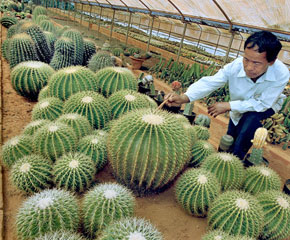Thought to have originated in central Mexico, the prickly pear cactus, or nopal as it is known locally, survives in searing deserts and freezing mountaintops and can be found in different forms across the Americas and parts of Europe.
Just 50 years ago it was an almost forgotten remnant of Mexico’s Aztec past, grown by poor indigenous families in their backyards as an insurance against food shortages.
But revived interest in the tangy tasting plant as an ingredient in Mexican cooking led to a farming boom centred in Milpa Alta on the edge of Mexico City, where rolling hills are carpeted with rows of the dark green cactus.
“Production is rising,” said farmer Miguel Villanueva at an event in Milpa Alta to promote the plant. “People are learning about nopal’s properties.”
Milpa Alta, a rural backwater where some people still speak the ancient Nahuatl indigenous tongue despite it being part of one of the world’s largest cities, is the centre of Mexico’s nopal industry.
An agriculture ministry said nopal sales are up 115 percent between 1999 and 2005, to $127 million. In 2006, sales jumped to $150 million. Alternative medicine companies have latched on to what they say is a cure-all cactus, a wonder plant capable of treating everything from diabetes to obesity and hangovers, sharply boosting plantings in the last decade.
Mexican health stores advertise Nopal remedies in pill and powder form and Milpa Alta is taking advantage of its proximity to Mexico’s capital to drive pickup trucks laden with the thorny pads to markets.
The cactus, which has a slimy texture similar to okra when cooked, is made into ice cream, grilled over charcoal and even mixed with cow brains at taco stands for a nutritious snack.
It contains protein, several vitamins and large doses of fibre, was central to Aztec symbolism and today features on coins and government seals.
While the U.S. government does not yet back the medicinal properties of the plant, herbal medicine firms are now promoting the results of Mexican research suggesting it can reduce blood sugar and help certain types of diabetes.

